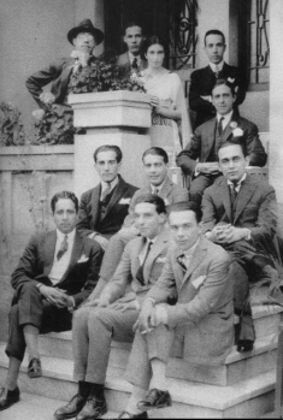Modernism is the main literary movement of the 20th century. Tightly influenced by the avant-garde movements that took place in Europe in the early 1900s, this literary style was revolutionary on several levels.
In Brazil, the initial milestone of Modernism was the 1922 Modern Art Week. Some of the main Brazilian authors framed within Modernism are: Mário de Andrade, Oswald de Andrade, Manuel Bandeira, Carlos Drummond de Andrade, Graciliano Ramos, Rachel de Queiroz, Clarice Lispector and Cecília Meireles.
See too:Read about the first literary school considered Brazilian
Historical context
The main historical facts that strongly influenced Modernism were:
First World War;
Nazism;
Fascism;
Second World War;
New York Stock Exchange Crash in 1929;
Latte Policy;
Getúlio Vargas government.
Modernism in Europe
In Europe, from the beginning of the 20th century, several new artistic movements began to emerge. Such movements were influenced for the industrialization and urbanization of the main social centers of the continent, with a population living more and more in cities and with technology visibly advancing. Called "vanguards”, these movements were the foundations of European and, later, Brazilian Modernism. The main vanguards were:
futurism
Cubism
Expressionism
Impressionism
Dadaism
Surrealism
From the literary experiences promoted by the avant-gardes, several authors produced works that would, therefore, become part of Modernism. In Portugal, some of the greatest writers of this movement are Fernando Pessoa, Mário de Sá Carneiro and José Saramago.
Read more: Discover the literary school that consolidated the national identity in Brazil
Modernism in Brazil

In photography, the organizers of the Week of Modern Art, among them Guilherme de Almeida and Mário de Andrade.
Brazilian Modernism had as its starting point the Modern Art Week, in 1922. Its authors remain among the most read in the country, and the movement's influence on Brazilian culture is enormous. Didactically, the main theorists of the theory of literature divide Modernism into three phases:
first modernist phase
In the first decade (1920 to 1930), the main authors of Brazilian Modernism created works that sought deconstruct national cultural identity to then reconstruct it in a new light.
Through the Pau-Brasil Manifesto It's from ManifestAnthropophagic, you can see that the movement's writers intended tell the history of Brazil from a more critical perspective and including the daily lives of the population. Oswald de Andrade, Mário de Andrade and Manuel Bandeira are the main authors of this phase. See, below, an excerpt from the “Pau-Brasil Manifesto”:
“Against cabinetism, the cultured practice of life. Engineers instead of jurists, lost like Chinese in the genealogy of ideas.
The language without archaisms, without erudition. Natural and Neological. The million dollar contribution of all mistakes. As we speak. As we are.
There is no struggle in the land of academic vocations. There are only uniforms. Futurists and others.
A single fight - the fight along the way. Let us divide: Import poetry. And the Poetry Pau-Brasil, for export."
Oswald de Andrade
second modernist phase
From the 30's to the mid 40's, a strong regionalist trend came into existence in Brazil. novels like the fifteen, by Rachel de Queiroz, or Dried lives, by Graciliano Ramos, recounted the hardships of the northeastern backlands population. Érico Veríssimo, in books like The time and the wind, in turn, narrated life in southern Brazil. Read below an excerpt from Dried lives:
"On the reddish plain, the juazeiros enlarged two green spots. The unfortunates had walked all day, they were tired and hungry. Ordinarily they walked little, but since they had rested a lot on the sand of the dry river, the journey had progressed well three leagues. They had been looking for a shadow for hours. The foliage of the juazeiro trees appeared in the distance, through the bare branches of the sparse catinga.
They crept towards it, slowly, Sinha Vitória with her youngest son straddling her room and the leaf chest on her head, Sombre Fabiano, wobbled, the yo-yo in the shoulder, the gourd hanging from a strap attached to the belt, the flintlock shotgun in the shoulder. The older boy and the Whale dog followed. The juazeiros approached, retreated, disappeared.
The older boy began to cry, he sat on the floor."
Graciliano Ramos
third modernist phase
Authors such as Clarice Lispector, Cecília Meireles, Guimarães Rosa and Vinicius de Moraes produced works of deep psychological density, without necessarily linking to a regionalist vision. Read a poem from this phase below:
4th reason for the rose
Do not worry about the petal that flies:
it is also to be, to stop being like that.
Roses will see, only puckered ash,
dead, intact throughout your garden.
I scent even my thorns
in the distance, the wind is talking about me.
And because of losing me, they remind me,
it's by defoliating myself that I have no end.
Cecília Meireles
Summary
Modernism is the main artistic movement of the 20th century. In Europe, he was influenced by European vanguards. In Brazil, the crisis of the “coffee with milk” governments, the world wars, among other relevant facts, produced a Modernism that can be understood in three phases. The first phase sought to reinvent the Brazilian cultural identity, the second phase portrayed the different regions and denounced the ills of the population, and the third phase has a broader theme and a clearer density psychological.

